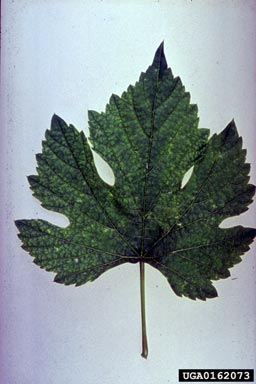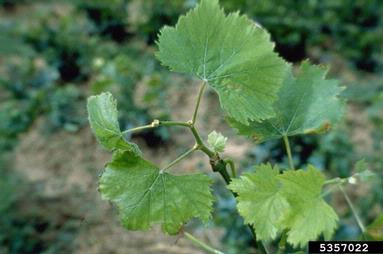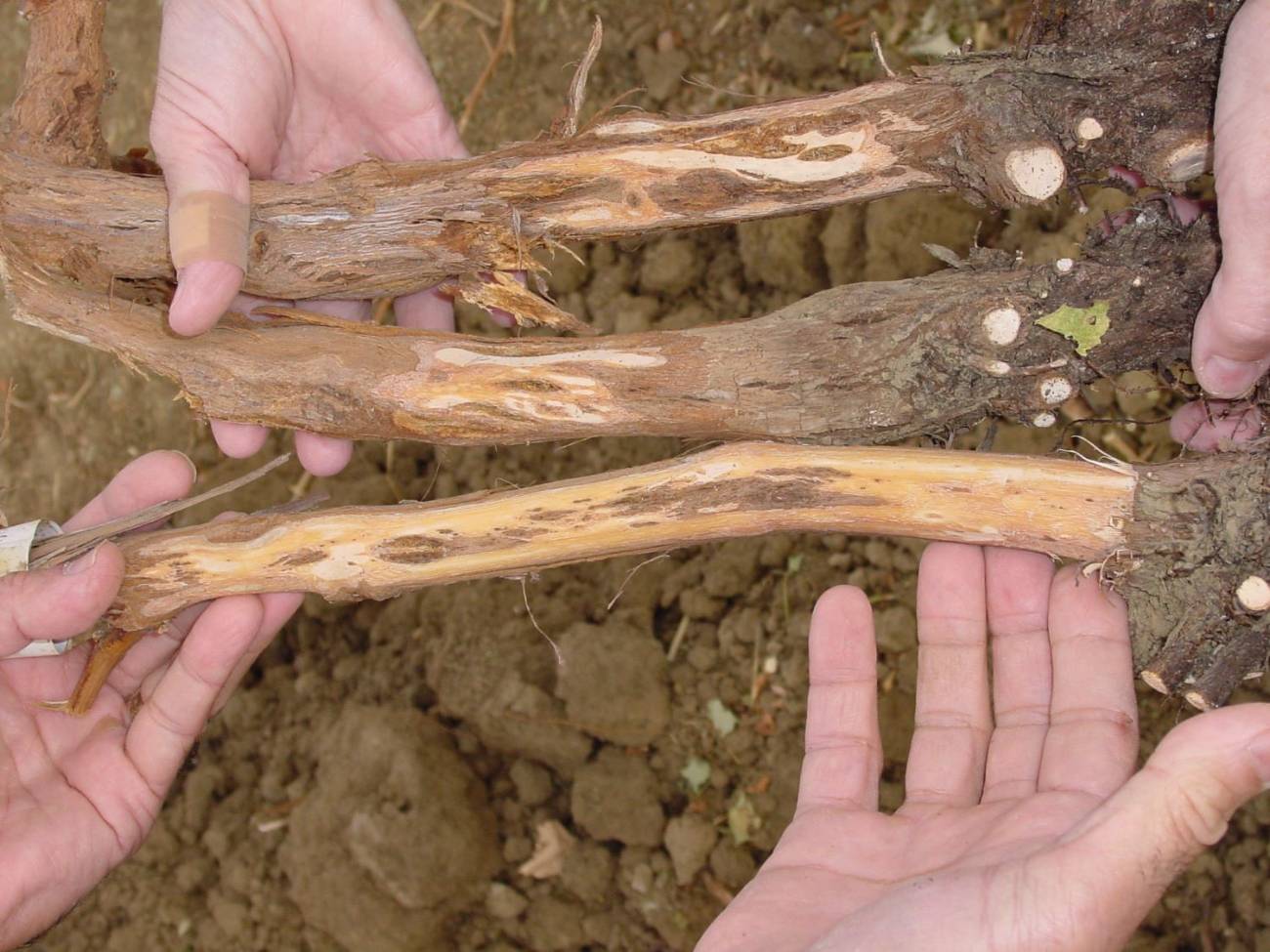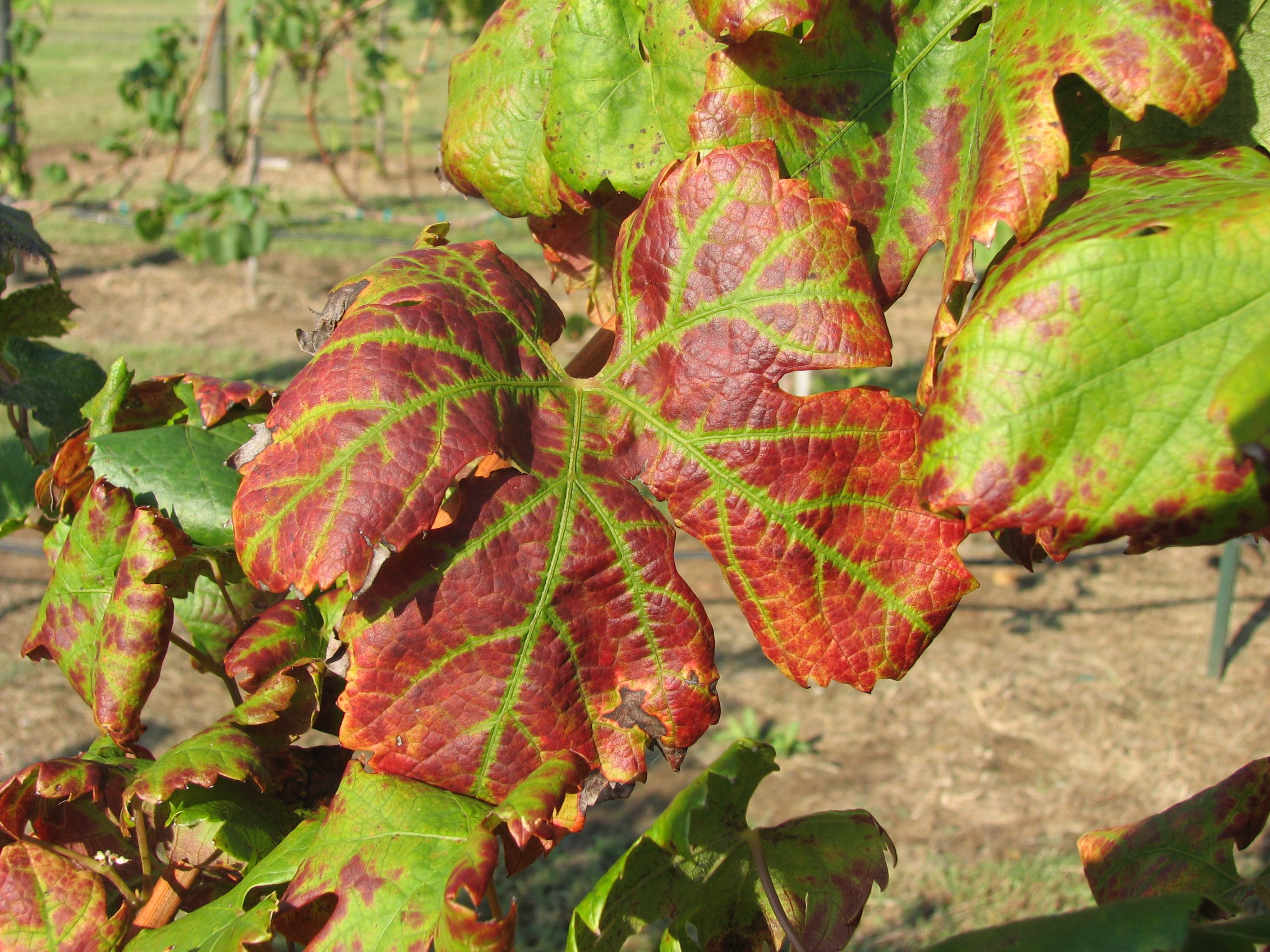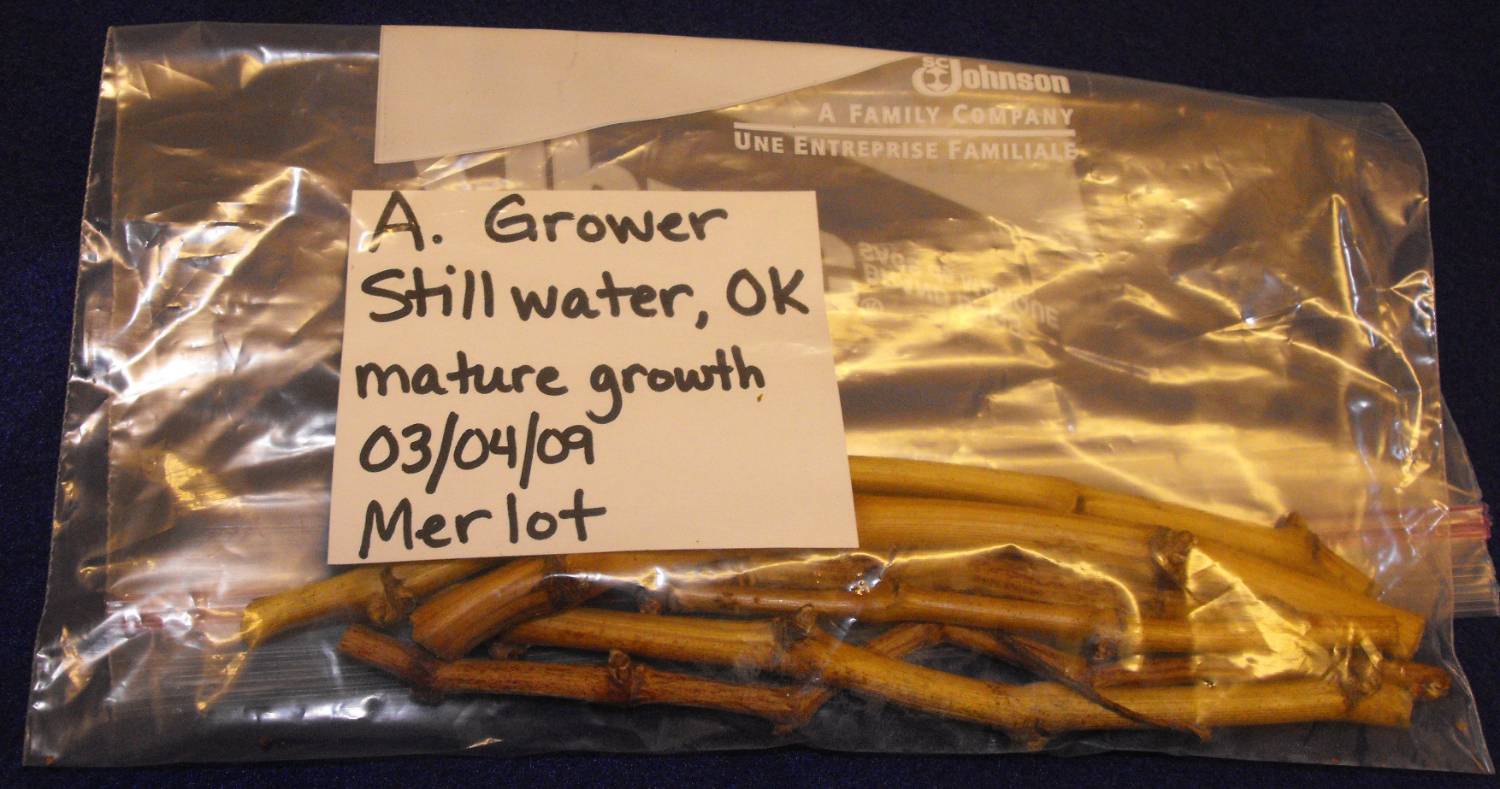Grapevine Disease Testing Services
- Jump To:
- Types of Plant Diseases
- Bacterial and Viral Diseases of Grapevine
- Laboratory Tests for Grapevine Pathogens
- Guidelines for Submitting Samples for Testing of Grapevine Pathogens
- Testing Options for Grapevine Pathogens
- Laboratory Services and Results
- Methods of Grapevine Virus Testing and Future Services
- About the PDIDL
Each season, the PDIDL receives inquiries regarding testing services for grapevine pathogens. Beginning in 2009, the PDIDL will offer special laboratory tests for a series of grape pathogens. In this leaflet, growers will find information about diseases of grapevine and sampling and submission guidelines.
Types of Plant Diseases
Plant diseases can be caused by both infectious and noninfectious agents. Non-infectious agents include environmental factors such as nutrition, moisture, or unusual weather events such as hail. These agents would not be transmitted to a healthy plant. A plant disease caused by an infectious agent occurs when an organism attacks a plant and obtains its nutrition from the plant. Some types of infectious agents include viruses, bacteria, nematodes and fungi.
Plant Diseases Caused by Viruses
Viruses are small, submicroscopic particles that consist of a protein coat and nucleic acid core. They require a living host for survival and multiplication. Viruses require a wound to gain entry into a plant, such as through grafting, pruning, certain types of insects, and nematodes. Once inside a plant cell, the virus can multiply and spread throughout the plant.
Infection with plant viruses is not usually lethal to a plant, but can affect quality, yield and the lifespan of plants. Symptoms caused by plant viruses include abnormal color or patterns such as mottling, mosaic, ringspots, and vein yellowing. Viruses may cause plants to have an abnormal leaf shape or distortion. They may cause atypical flowers as well as abnormal fruit size, shape or color.
Viruses spread slowly in vineyards and they can be managed by planting clean stock and sanitation. Infected vines should be removed and replaced with healthy plants.
Plant Diseases Caused by Bacteria
Bacteria are microscopic, single-celled organisms which reproduce by dividing in half (binary fission). Bacteria which cause diseases in grapevine enter plants passively through wounds, grafting, or insect vectors.
Plant diseases caused by bacteria may cause symptoms such as unusual growths or galls and leaf symptoms such as yellowing, necrosis (browning), and leaf drop. Infected plants often exhibit dieback and over time, the entire plant may die.
Bacterial diseases are generally controlled by planting clean stock and good sanitation practices. Infected plants should be removed and discarded. Bacteria can survive in plant debris and soil for either short or long periods depending upon the organism.
Plant Diseases Caused by Nematodes
Nematodes are small, round worms that live in the soil or plant tissues. Plant parasitic nematodes possess a stylet which is a needle-like device that is used to feed on plant cells. Plant parasitic nematodes are more common in loose, sandy soils then heavy clay soils.
Plant parasitic nematodes do not generally kill plants, but cause reduced growth and
vigor. The plants may appear stunted or yellow and may exhibit dieback. Root growth
and development is often poor and some nematodes may induce root deformation. Some
types of nematodes such as dagger nematodes (Xiphinema spp.) can transmit virus diseases.
Plant parasitic nematodes are managed by selecting rootstock that is resistant to
nematodes and leaving infested soil fallow for several years.
If nematode problems are suspected, it is recommended that growers submit soil samples
to determine the nematode species present and to obtain an estimate of their population.
If previous plants were affected by nematodes, the population levels may be high enough
to cause damage to young vines. To sample for nematodes, growers should collect soil
samples measuring about 1 foot deep in the root zone of grapevine plants. The top
2 to 3 inches of soil should be discarded. Any roots encountered should be included
in the sample. The soil should be mixed thoroughly and growers should submit approximately
1 pint of soil for analysis to the PDIDL. A second soil sample from a healthy plant
in a similar type of soil should also be submitted.
Samples should be kept cool (do not freeze) until shipped. A sample submission form
can be obtained at http://entoplp.okstate.edu/pddl/ or by phone at 405-744-9961. The
PDIDL charges $15 for each nematode sample submitted, but there is no charge for submission
of the healthy sample.
Plant Diseases Caused by Fungi
Fungi are eukaryotic organisms that can live on a wide variety of substrates including plants and soil debris. Fungi reproduce both sexually and asexually by the production of spores. Diseases caused by fungi may be spread by air, water or animals or they may be soilborne.
Fungi cause many types of symptoms on plants including leaf spots, dieback and root
decay. Some types of fungi affect a variety of plants while others are specific to
one or a few types. Control of fungal diseases varies depending upon the specific
organism, but may include sanitation, resistance and/or fungicides.
The PDIDL routinely examines grapes and other plants for problems that are suspected to be caused by fungal pathogens. If you would like to submit a sample to be examined for a fungal pathogen, please visit our website at http://entoplp.okstate.edu/pddl/ or contact us at 405-744-9961 for a copy of our general plant diagnostic submission form and submission guidelines. Our basic sample fee is $10 per sample which includes a preliminary examination and basic microscopy. If additional tests are needed, growers will be contacted by our staff with an estimate of our fees (generally an additional $20 to $50 per sample) and approval to run these tests.
Bacterial and Viral Diseases of Grapevine
Arabis Mosaic Virus (ArMV)
Symptoms of arabis mosaic virus (ArMV) include mottling and flecking on the leaves and leaf deformation including enations (bumps). Infected plants may have shortened internodes and exhibit vine decline symptoms. The symptoms are similar to those of fanleaf and mixed infections of ArMV and Grapevine Fanleaf Virus are common. Infections are often symptomless and expression varies based on type of rootstock, variety, and environmental conditions. Yield losses of up to 50 percent have been attributed to ArMV.
This virus has been reported as common in grapevines in other states and is widespread
in Europe. Dagger nematodes are reported to transmit ArMV from diseased to healthy
plants. The primary method of spread is through movement of infected propagation material.
Strawberries, raspberries, cherry, peach, and plum are also hosts of ArMV.
Photo courtesy Biolog. Bundesans., Inst. f. Pflanzenschutz im Weinbau Archive, Germany, Bugwood.org
Crown Gall – Agrobacterium vitus and A. tumefaciens
Crown gall is a common disease in vineyards caused by two species of bacteria, Agrobacterium vitis and A. tumefaciens. It may affect only a few vines or the total vineyard. The symptoms include development of galls (tumors) which are most commonly observed at the soil-line. However, galls can be observed at all portions of the vine when injuries occur. The galls are tan to green at first, but turn brown to black and become woody as they age. Galls are not usually observed on grape roots, but necrosis (blackening and death) of root tissues may occur.
The disease causes reduced vigor and yield loss. Sometimes plants harbor the bacterium,
but do not express visible symptoms. A. tumefaciens can survive in soils and vine
debris while A. vitis does not survive well in soil, but can be harbored in root debris.
Most infections are due to planting infected plants or cuttings. A tumefaciens has
a wide host range which includes many other fruit crops, while the host range of A
vitis is limited to grape. A. vitis is typically the cause of crown gall in grapevine.
Photo courtesy Canadian Food Inspection Agency
Fanleaf - Grapevine Fanleaf Virus (GFLV)
Grapevine Fanleaf Virus (GFLV) is thought to be the most serious virus disease affecting grapevines. Fanleaf causes distortion of leaves and may cause unusual chlorotic (yellow) patterns on leaves such as a yellow mosaic or yellow veins. Plants that are infected with GFLV may be reduced in size compared to healthy plants. Fruit quality and winter hardiness are often reduced. Fruit losses of up to 80 percent have been reported in some varieties. The disease is spread by dagger nematodes, however, presence of the nematode is not required for infection in a vineyard since the virus is frequently spread by movement of infected plant material.
Photo courtesy William M. Brown, Jr., Bugwood.org
Grapevine Virus A (GVA), Grapevine Virus B (GVB)
Grapevine Virus A (GVA) and Grapevine Virus B (GVB) are also called vitiviruses and are associated with the rugose wood complex diseases. Grapevines affected by this complex exhibit pitting and grooving under the bark. These viruses are generally transmitted by propagation of infected material. Symptoms associated with GVA include reddening of leaf margins and petioles, poor vigor, and leafroll. The plant may exhibit swelling at the graft union and stem cracking. Ungrafted vines may be infected with GVA, but do not show visual symptoms. GVB causes corky bark, which can be seen when the bark on the trunk is removed. GVB only occurs in grafted vines.
Photo courtesy Bev Ferguson, University of California, Davis
Leafroll – Grapevine Leafroll-Associated Viruses (GLRaVs)
Leafroll is probably the most widespread virus disease of grapevines. Leafroll symptoms are associated with at least nine different viruses that are referred to as Grapevine Leafroll-Associated Viruses (GLRaVs). The distinct viruses are referred to as GLRaV-1 through GLRaV-9. Laboratory tests are only commercially available for six GLRaVs. GLRaV-1 and GLRaV-3 are the most commonly found viruses in the group.
Grapevines infected with leafroll often show downward curling of the leaves and leaf
thickening. The leaves of red fruited varieties may turn red in late summer while
the veins may remain green. White fruited varieties may not show reddish color and
only show downward leafroll. Infected plants are more susceptible to environmental
stress. The fruit may have poor color development, a 25 to 50 percent- reduction in
sugar content, and delayed maturity. Yield is reduced due to inhibition of cluster
formation and development.
The virus is spread primarily by movement of infected propagation material. Some insects
(mealybugs and soft scales) have been shown to transmit the disease under experimental
conditions, but it is not known if this method of transmission is important in Oklahoma.
Transmission by mealybugs is very slow under field conditions.
Photo courtesy Oklahoma State University
Pierce’s Disease – Xylella fastidiosa
Pierce’s Disease is caused by a bacterium that lives in the xylem (water-conducting) cells of plants. The symptoms are observed in late summer and fall and include marginal leaf scorch (browning) that is frequently bordered by a red or yellow halo. Entire leaves may turn brown and drop, leaving the petioles attached to the plant. Fruit clusters may shrivel and shoot growth is often stunted.
The disease is transmitted by xylem-feeding insects including sharpshooters and leafhoppers.
Long distance movement is due to infected plant material.
Pierce’s Disease was first identified in grapes in Canadian County, Oklahoma in 2008
in a home garden. At this time, we do not know the distribution of Pierce’s Disease
in Oklahoma. Other strains of Xylella fastidiosa that affect shade trees have been
routinely found throughout Oklahoma. This indicates that the grape-infecting strain
could survive throughout the state. The strain of the bacterium that affects shade
trees does not cause Pierce’s Disease.
Photo courtesy Casey Sharber, Oklahoma Cooperative Extension Service
Tobacco Ringspot Decline –Tobacco Ringspot Virus (TRSV) and Yellow Vein-Tomato Ringspot Virus (ToRSV)
Tobacco Ringspot Virus (TRSV) causes symptoms that are similar to Tomato Ringspot Virus (ToRSV) and can lead to general grapevine decline. Yellow vein is also known as tomato ringspot disease or decline. Both diseases cause reduced vine vigor and shoot stunting. Infected plants are highly susceptible to cold damage and may yield small clusters of grapes. Symptoms can resemble those caused by other viruses. The viruses are transmitted by dagger nematodes. The diseases are more common in vineyards in the Eastern United States. The viruses are often moved with infected propagation material.
Photo courtesy Elwin Stewart, Dept. of Plant Pathology, PSU
Laboratory Tests for Grapevine Pathogens
In the vineyard, disease symptoms are frequently reported by growers. However, the symptoms observed could be the result of several causes. For example, red leaf discoloration may be due to viral infection, nutrient imbalance, a root problem, insect feeding, or physical damage. Leaf scorch may be due to water or nutrient imbalances, chemical injury, or Pierce’s disease. Submitting samples for pathogen testing can often determine the cause of the unusual symptoms.
For many grapevine diseases, symptoms are expressed only during a certain time of
the year. For example, symptoms of Pierce’s disease and leafroll are generally observed
in the late summer and fall. If plants are examined in the spring, typical symptoms
of these diseases would not be observed. Additionally, grapevines infected with some
pathogens may never show clear symptoms, but yield and plant vigor may be reduced.
These symptomless infections can generally be detected by laboratory tests.
Laboratory tests are not available for every potential grape disease, so plants cannot
be declared completely “disease-free.” Our tests detect the most common grapevine
pathogens and can be used to assess the overall health of the vineyard and planting
stock used to establish new vineyards.
Figure 1. Properly labeled and packaged sample.
Guidelines for Submitting Samples for Testing of Grapevine Pathogens
- Plant samples should be submitted during the appropriate time of the year. See Table 1 .
- When sampling vines, growers should use a disinfectant to clean cutting tools between cuts.
- Each sample should include six pieces of appropriate plant material (see Table 1) measuring 8 to 12 inches long. Be sure to sample from both sides of the cordon.
- Vine tissue should be placed in a sealable plastic bag for shipment. If you would
like to submit samples from outside Oklahoma, please contact thePDIDL for special
packaging instructions and out-of-state fees. Be sure to clearly label the bag with
the following information as shown in Figure 1:
- Grower’s name and location of the vineyard.
- Type of plant material – mature or new plant growth, galls, roots, etc.
- Date the sample was collected.
- Sample name or number – a description/variety so that you can return to the sampled plant.
- Include a completed grapevine sample submission form. Indicate which pathogen screen(s) you would like each sample tested for.
- Ship your samples as soon as possible after collection. If there is a delay in shipment, the bags can be stored in a refrigerator for a few days. Use of an overnight shipping service is recommended.
- Prepayment is required for testing of grapevine pathogens. We cannot accept credit cards at this time. Please include a check made out to: Oklahoma State University.
Table 1. Time of year and type of plant material to sample for grapevine pathogens.
| Disease | Pathogen | When to test | Plant material to sample |
|---|---|---|---|
| Arabis Mosaic | Arabis Mosaic Virus (ArMV) | Spring to early summer | Active Shoot tips from new growth (top of plant). |
| Crown Gall | Agrobacterium tumefaciens, A. vitis | All year | Gall tissue, tissue near the graft union. |
| Fanleaf | Grapevine Fanleaf Virus (GFLV) | Spring to early summer, winter | Active Shoot tips from new growth (top of plant). |
| Leafroll | Grapevine Leafroll- associated Viruses (GLRaVs) | Spring, late summer, fall, and winter | 8- to 12-inch vine sections from mature portion of vine. Include leaves if present. |
| Pierce’s Disease | Xylella fastidiosa | Late summer and fall | Symptomatic leaves and shoots from different areas of the plant. |
| Rugose Wood Complex/ Vitiviruses | Grapevine Virus A (GVA) or Grapevine Virus B (GVB) | Spring or winter | 8- to 12-inch vine sections from mature portion of vine. Include leaves if present. |
| Tobacco Ringspot Decline | Tobacco Ringspot Virus (TRSV) | Spring to early summer | Active Shoot tips from new growth (top of plant). |
| Yellow Vein | Tomato Ringspot Virus (ToRSV) | Spring to early summer | Active Shoot tips from new growth (top of plant). |
Testing Options for Grapevine Pathogens
Screen A – 12 pathogen tests
$200 for first sample, $150 each for additional samples, $125 each for 10 or more additional samples
| Tests included: | |
|---|---|
| GFLV | Grapevine Fanleaf Virus |
| GVA | Grapevine Virus A |
| GVB | Grapevine Virus B |
| GLRVs | Grapevine Leafroll Viruses1,2,3,5,6,7 |
| ArMV | Arabis Mosaic Virus |
| ToRSV | Tomato Ringspot Virus |
| TRSV | Tobacco Ringspot Virus |
Screen B – 8 pathogen tests
$130 for first sample, $100 each for additional samples, $85 each for 10 or more additional samples
| Tests included: | |
|---|---|
| GFLV | Grapevine Fanleaf Virus |
| GLRVs | Grapevine Leafroll Viruses1,2,3,5,6,7 |
| ArMV | Arabis Mosaic Virus |
Screen C – 6 pathogen tests
$100 for first sample, $85 each additional sample, $75 each for 10 or more additional samples
| Tests included: | |
|---|---|
| GLRVs | Grapevine Leafroll Viruses1,2,3,5,6,7 |
Screen D – 4 pathogen tests
$80 for first sample, $70 each additional sample, $60 each for 10 or more additional samples
| Tests included: | |
|---|---|
| GLRVs | Grapevine Leafroll Virus 1 & 3 |
| GVA | Grapevine Virus A |
| GVB | Grapevine Virus B |
Individual Virus Tests
$20 for first sample, $18 each additional sample (same virus), $15 each for 10 or more additional samples (same virus)
| Tests included: | |
|---|---|
| Your choice of virus test | call to confirm availability |
Screen CG – 1 pathogen test
$50 for first sample, $40 each additional sample, $30 each for 10 or more additional samples
| Test included: | |
|---|---|
| Crown gall | Agrobacterium species |
Screen PD – 1 pathogen test
$50 for first sample, $40 each additional sample, $30 each for 10 or more additional samples
| Test included: | |
|---|---|
| Pierce’s Disease | Xylella fastidiosa |
Laboratory Services and Results
Turn-around time for grapevine virus and bacteria testing is approximately one week from when the samples are received. Once testing is completed, the grower will receive a complete report that includes the results of each test conducted. Reports will be sent by e-mail, if provided, or U.S. mail.
Please be aware that no diagnostic test is without flaws. The methods employed by
the PDIDL are standard methods used by plant diagnostic laboratories. False positive
and false negative results can occur due to contamination of samples in the field
or laboratory. It is important that growers sanitize pruners between vines and properly
label samples in the field.
False negatives are more common than false positives and may occur when the pathogen
is unevenly distributed in the plant, the plants were not sampled at the proper time
of year, or the sample was in poor condition upon arrival. In the laboratory, we follow
good laboratory practices, and use both positive and negative controls to validate
the results of each test.
If you receive a negative result but suspect that there is a problem with the plant,
it may be necessary to submit additional samples for testing. The plant should continue
to be monitored. Since the concentration of the pathogen varies throughout the year,
a negative test does not always mean the vine is free of the disease. Sampling the
proper plant parts at the proper time of year is critical.
Methods of Grapevine Virus Testing and Future Services
In the 2009 season, all grapevine virus diseases will be tested using the Enzyme Linked Immunosorbent Assay (ELISA) method. Crown gall and Pierce’s Disease are detected using the Polymerase Chain Reaction (PCR) method.
On the grapevine sample submission form, growers will be asked whether or not they
authorize the PDIDL to conduct additional tests on their samples. There will be no
charge to the grower if we conduct additional tests and the results of the tests will
be shared with the submitter. The PDIDL is in the process of validating PCR techniques
for some grapevine viruses. The PCR method is more sensitive than ELISA and may allow
us to test during a wider seasonal time frame. We hope to have these tests available
in the future.
About the PDIDL
The primary goal of the Plant Disease and Insect Diagnostic Laboratory (PDIDL) is to provide residents in the State of Oklahoma with both accurate diagnoses of plant diseases and insect pests and recommendations for their control. The PDIDL operates throughout the year to provide plant disease and insect identification services to Extension agents, individuals, consultants, and commercial producers.
In addition to serving the residents of Oklahoma, the PDIDL is a member of the National
Plant Diagnostic Network (NPDN) and Great Plains Diagnostic Network (GPDN). The mission
of the NPDN is to enhance US agricultural security by quickly detecting, identifying
and reporting introduced plant pathogens and other pests.
If you have additional questions about grapevine diseases, sample submission or the
services offered by the PDIDL, please contact:
Department of Entomology and Plant Pathology
127 Noble Research Center
Oklahoma State University
(405) 744-9961
jen.olson@okstate.edu
Jen Olson
Assistant Extension Specialist/Diagnostician
Damon Smith
Extension Specialist

